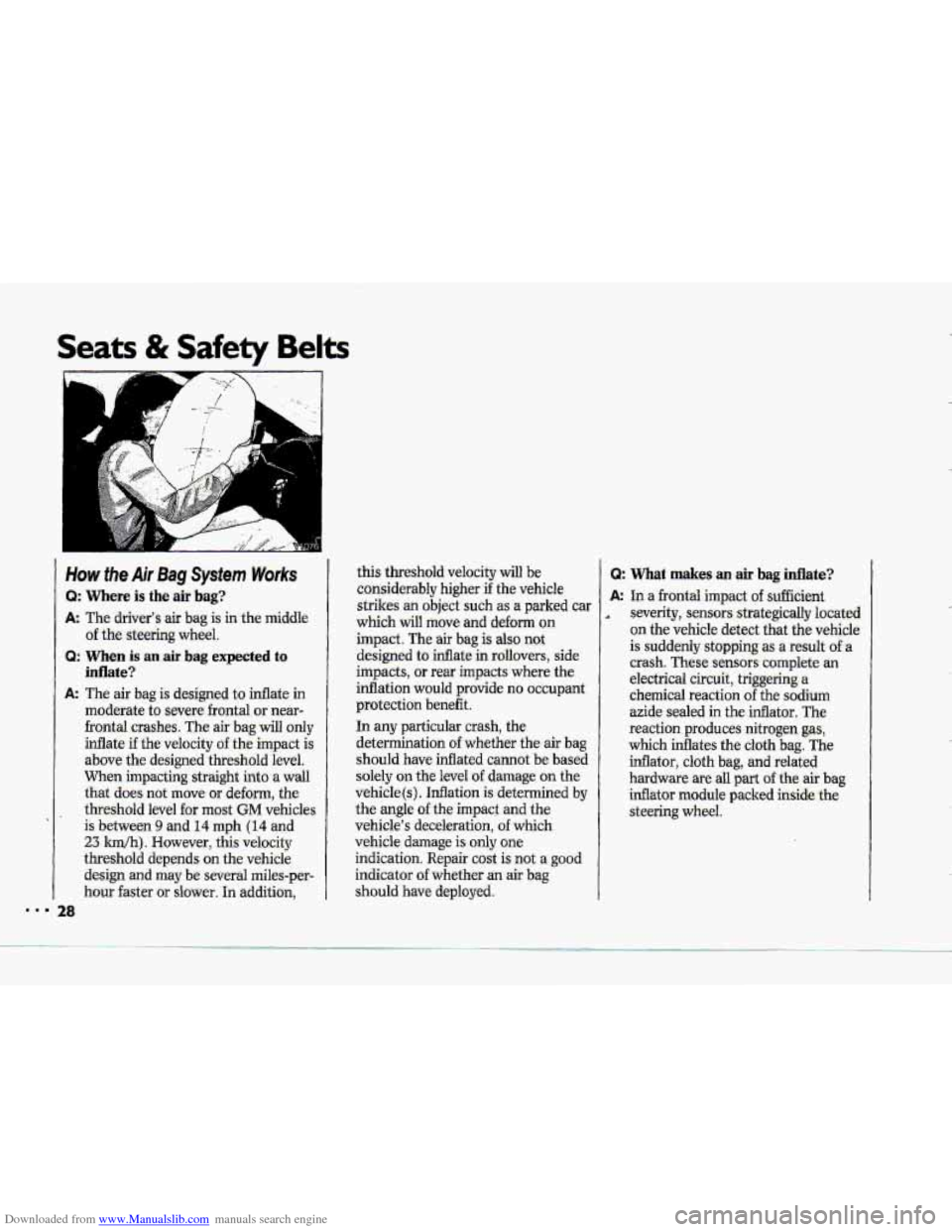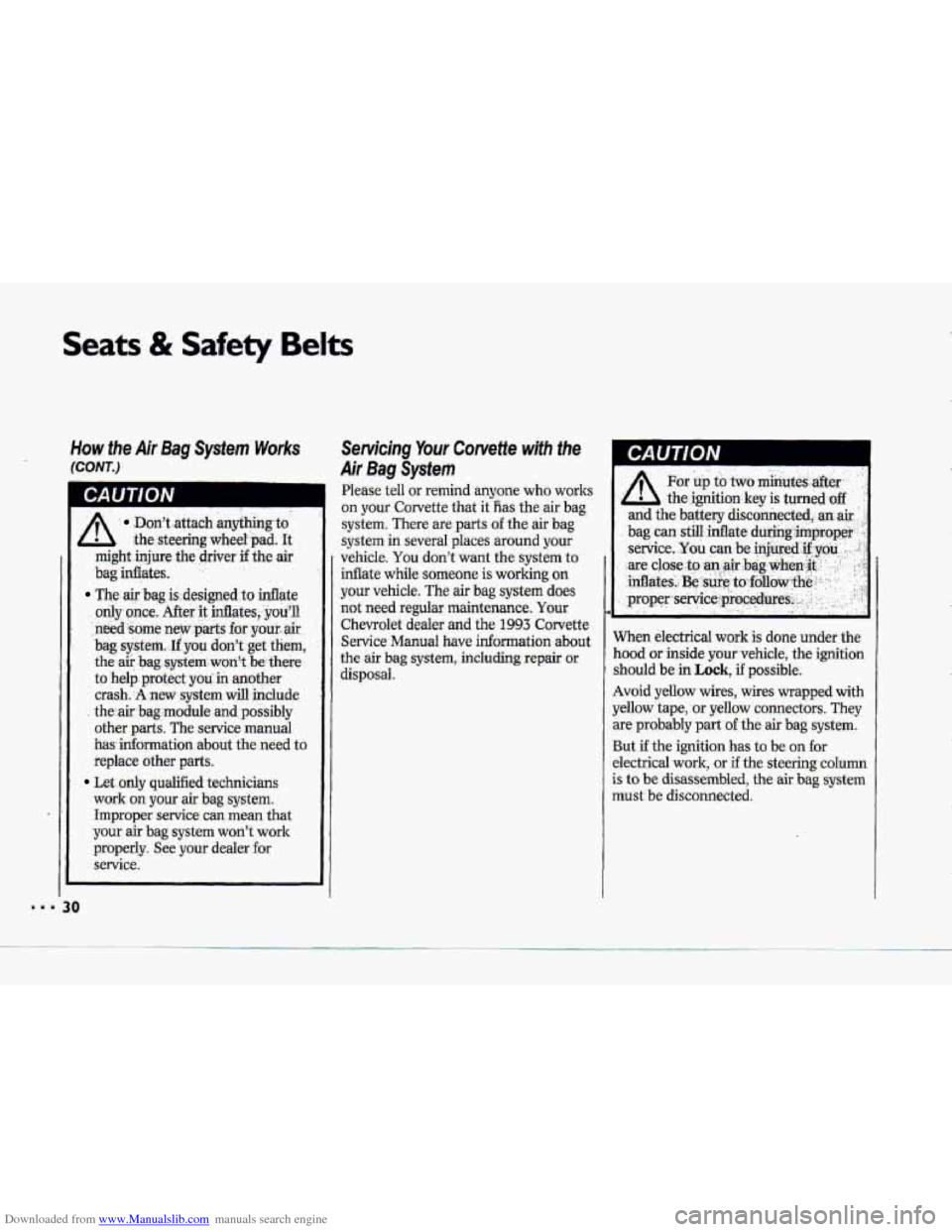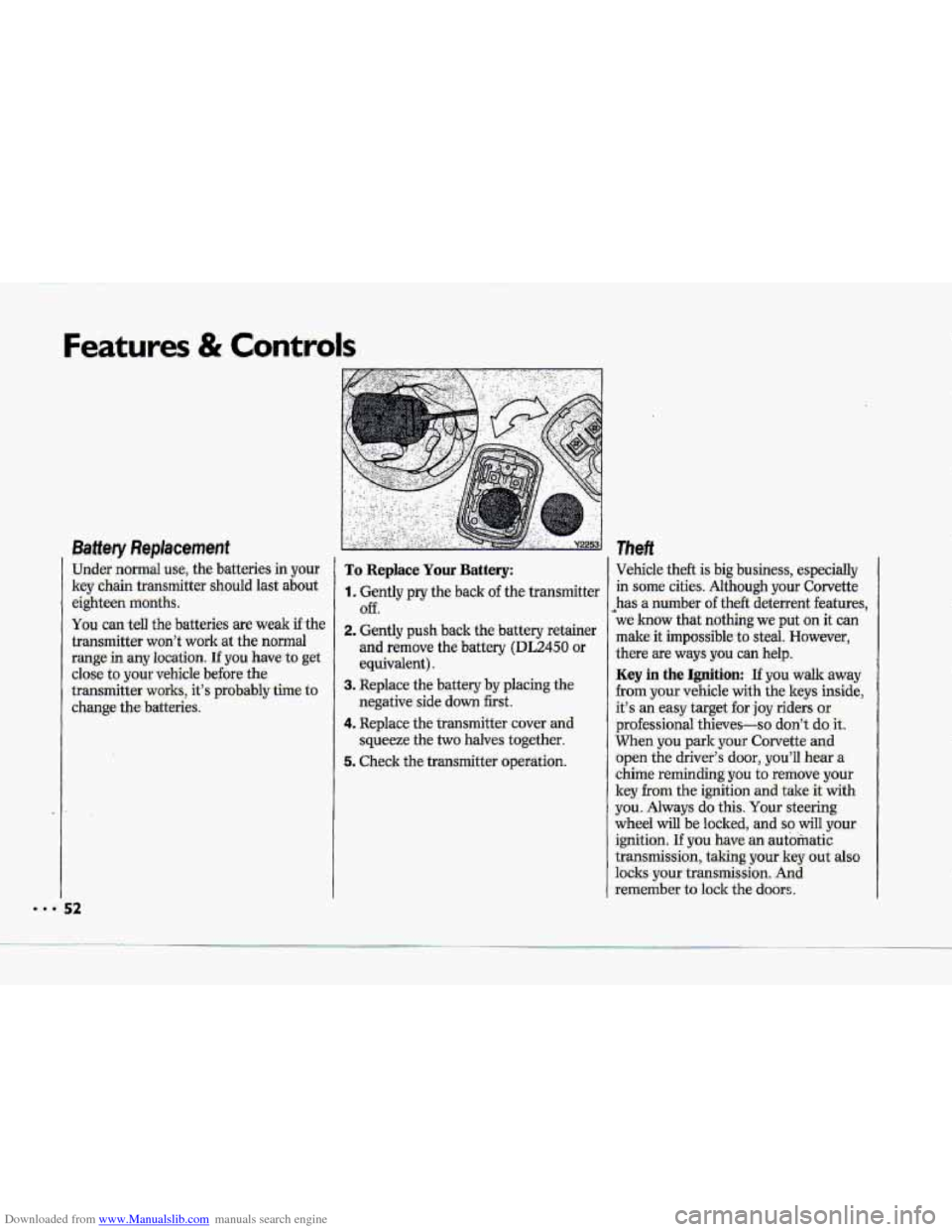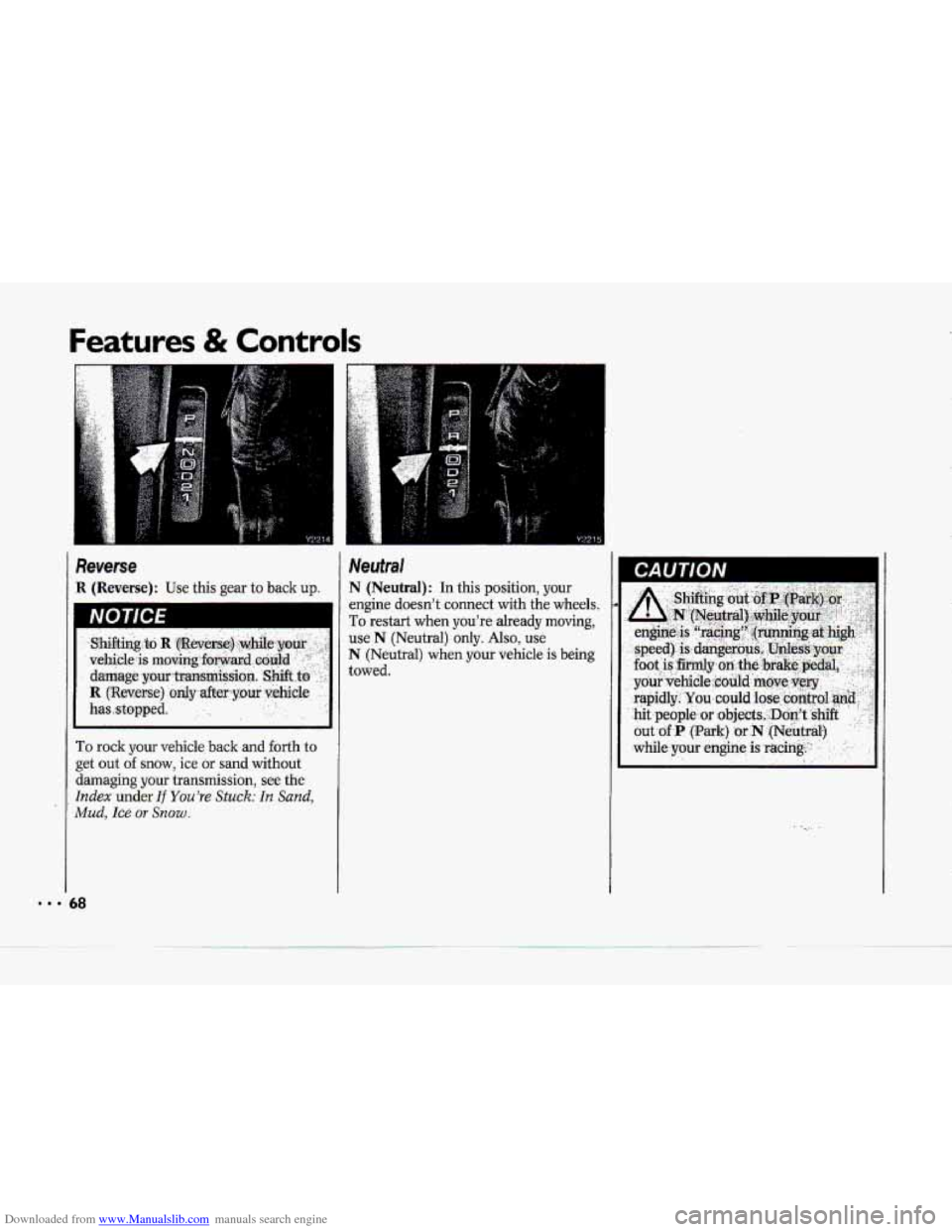1993 CHEVROLET CORVETTE wheel
[x] Cancel search: wheelPage 20 of 370

Downloaded from www.Manualslib.com manuals search engine T
-1-
Why Safety Belts Work
When you ride-in or on anything, you
go -as fast as it goes.
1. For example, if the bike is going 10
-mpfi (16 km/h), so is the child.
2. When the bike hits the block, it
stops. But the child keeps going!
3. Take the simplest "car." Suppose
it's just- a seat on wheels.
.-a
"'"I"
Page 29 of 370

Downloaded from www.Manualslib.com manuals search engine Seats & Safety Belts
How the Air Bag System Works
Q: Where is the air bag?
A The driver's air bag is in the middle
of the steering wheel.
Q: When is an, air bag expected to
inflate?
A: The air bag is designed to inflate in
moderate to severe frontal
or near-
frontal crashes.
The air bag will only
inflate if the velocity of the impact is
above the designed threshold. level.
When. impacting straight irito a
wall
that does not move or deform, the
tbeshold level for most GM vehicles
is between 9 and 14 mph (14 and
23 ldh). However, thi,s velocity
threshold depends on
the vehicle
design
and may be several miles-per-
hour faster
or slower. In addition,
28
this threshold velocity will be
considerably higher if the vehicle
strikes an object such as a parked car
which
will move and ,deform on
impact. The air bag is also. not
designed to inflate in rollovers, side
impacts, .or rear impacls where the
inflation would provide no occupant
protection benefit.
In any
particular ;crash, the
determination
of whetherthe ail bag
should have inflated cannot be based
solely on the level of dgrnage on the
vehicle(s).. Inflation is-determined by
the angle of the impact and the
vehicle's deceleration,
of which
vehicle
damage is only one
indication. Repair cost is not a good
indicator of whether an air bag
should.
have deployed.
Q: What makes -an air bag inflate?
A: In a.frontal impact of sufficient
severity, sensors strategically located
an the vehicle. detect th& the vehicle
is. suddenly stopping .as a result of a
crash. These sensors complete an
electrical circuit, triggelling-
a
chemical reaction of the sodium-
az-ide sealed in the .inflator. The
reaction produces nitrogen
gas;
which inflates the cloth bag. The
inflator, cloth bag,
and related
hadwareare all
part of the air bag
inflator module packed inside the
steering wheel.
Page 30 of 370

Downloaded from www.Manualslib.com manuals search engine i
Q: How does an air bag restrain?
A: In moderate to severe frontal or
near=frontal collisions, even belted
occupants
can contact the steering
wheel. The air bag supplements the
protection
provided by safety belts.
Air bags distribute the force of the
impact more
evenly over the
occupant's
upper body, stopping the
occupant
more gradually. But air
bags would not provide protection in
many types of collisions; including.
rollovers and rear and side impacts,
primarily because
an occupant's
.: - motion is not toward the air bag. Air
bags should never be regarded as
anything more than a supplement to
safety belt protection in hoderate to
severe frontal
and near-frontal
collisions.
Q: What wiu you see after an air bag
Mation?
A: Mer the air bag has inflated, it will
then quickly
deffate. This occurs so
quickly that some people may not
even realize that the air bag Sated.
The air bag will not impede the
driver's vision
or ability to steer the
vehicle,
nor will it hinder the
occupants from exiting the vehicle.
There
will be small amounts of
smoke
coming from vents in the
deflated
air bag. Some components
of the air bag module in the steering
wheel
hub may be hot for a short
time, but the portion of the bag that
comes into contact
with you will not
be hot to the touch. The nitrogen gas
used to inflate the air bag will have ventdinto
the passenger
compartment, and the
bag will be
deflated within seconds after the
"collision. Nitrogen makes
up about
80% of the air we breathe and is not
hazardous. As the nitrogen vents
from the bag, small particles we also
vented into the passenger
compartment.
29
Page 31 of 370

Downloaded from www.Manualslib.com manuals search engine Seats & Safety Belts
How fhe Air Bag System Works
(CONT.)
CAUTION
Don’t attach .anything’to
A the steering wheel pad. It
might injure the driver if the air
bag
inflates.
The air bag isdesigned to inflate
only once. After it inflates, you”ll
.n~ed ‘some new parts €or
your:. air
bag system. .If you don’t get them,
the air bag system won’t be there
to help.protect
you in another
crash. -A new system will include
the:air bag.module and possibly
other
parts. The service manual
has. information about the need
to
replace other parts.
Let oniy qualified technicians
work on yow air bag system.
Improper service can mean that
your air bag system won’t work
properly. See your dealer
for
service.
30
Servicing Your Corvette with the
Air Bag System
Please tell or remind anyone who works
on your Corvette that
it fias the air bag
system. There are parts
of the air bag
system in several places around your
vehicle.
You don’t want the system to
inflate while someone is working
on
your vehicle. The air bag system does
not need regular maintenance. Your
Chevrolet dealer and the 1993 Corvette
Service Manual have information about
the air bag system, including repair or
disposal.
When electrical work is done under the
hood or inside your vehicle, the ignition
should be in
Lock, if possible.
Avoid yellow wires, wires wrapped with
yellow tape, or yellow connectors. They
are probably part
of the air bag system.
But if the ignition has to be on for
electrical work, or if the steering column
is to be disassembIed, the air bag system
must be disconnected.
-_ -.
Page 53 of 370

Downloaded from www.Manualslib.com manuals search engine -
Features & Contr ,Is
Baff ery Replacement
Under normal use., the batteries in your
key chain.tramnitter should last about
eighteen months.
You can tell the batteries are weak if the
transmitter won’t workat
the normal
range in any location. If you have to get
close to your vehicle before the
transmitter
works, it’s probably time to
change the batteries.
To Replace Yaw Battery:
1. Gently pry the back of the transmitter
Off.
2. Gently push back the batteryretainer
and remove the battery (DL2450 or
equivalent),
-3. Replace the battery by placing the
negative side
down first.
4. Replace the transmitter covmand
squeeze the
two halves together.
5. Check the transmitter operation.
Theft
Vehicle theft is big business, especially
in
some cities. Although yo.ur Corvette
$as a number
of theft deterrent features,
we how that nothi-ng we put on it can
make it impossible to steal. However,
there are ways you can help.
Key in the Ignition: If you walk awgy
from your vehicle with the keys inside,
it’-s ;an.easy target far joy riders or
professional thieves-so don’t do it.
When you park your Corvette and
open the driver’s door, you’ll heat a
chime reminding you to remove your
key from the ignition and take it with
you.
Always do this. Your steering
wheel will be locked, and so will yo.ur
ignition.
I€ you have-an autbmatic
transmission,,
taking your key out also
locks your transmission-. And
remiember to lock the doors.
Page 61 of 370

Downloaded from www.Manualslib.com manuals search engine Features & Controls
Ignition Switch
With the-ignition key in the ignition
switch, you can turn
the switch to five
p.ositions:
Accessory: An “on” position in which
you
can operate your .electrical power
accessories. Press in the-ignition .switch
as
you turn the top of it toward you.
Lock: The only position in which you
can remove the key. This locks your
steering wheel, ignition. and automatic
shift lever.
UE Udo:cks the steering wheel,
ignition, and automatic shift lever. Use
this pasition if your vehicle must be
pushed or towed, but never try to push-
start your vehicle-.
A warning chime will
sound if you open the driver’s door when
the ignition is
off and the key is in
the ignition.
Run: An “on” position to which the
switch returns after you start your
engine and release the switch. The
switch stays in
the Run position when
the engine is running. But -even when
the engine is-not running, you can use.
Run to operate your electrical power
accessories,
and to display some instru-
ment panel warning lights.
Start: Starts the engine, When the
engine starts, release the key. The
ignition switch will return to
Ruil fot
noma1 driving.
Note
that even if the engine is not
running, the positions
Accessory and
Run are “on” positions that allow y0.u
to operate your electrical accessories,
such
as the radio.
Key Release Button
(MANUAL TRANSMISSION)
..With a manual transmission, the
ignition key c-ot be removed from
the ignition unless the key release
button is used.
To Remove the Key:
Turn the key to the Lock position while
pressing the
key release buttoa down at
the same time. Keeping your thumb on
the button, pull the key straight out.
Page 68 of 370

Downloaded from www.Manualslib.com manuals search engine 9 Shifting the Automatic
Transmission
Your automatic transmission has a shift
-lever located on the console- between
the seats.
There
sire several different positions for
your shift lever.
Park
Reverse
Neutral
Overdrive
Drive
Second
First
P -
D
D
2
1
Park
P (Park): This loclts your rear wheels.
It’s the
best position to use when you
start your engine because your vehicle
can’t move easily.
CAUTION I
It is dangerous to,:get oui:-af :
your ‘vehicle -3 th&hift lever
is not fully in P (Park) ,with the
p”arkinglbrdce~My set. your
vehicle :can roll. ’
Don’t leave your,vehicle when the
engine is running unless you have
to. If you have left the engine
running, the vehicle can -move
suddenly.
You or ,others could be
injured. To be sure your vehicle
won’t move, when you”re
on fairly
level ground, always set. your
parking brake and move the shift -
lever to P -(Park).
See the
Index under Shifting Into
hill, also see the Index under
Parking on Hills.
P (Park). If you are parking 0ri:a.
Page 69 of 370

Downloaded from www.Manualslib.com manuals search engine Features & Controls
Reverse
R (Reverse): Use this gear to back up.
To rock your vehicle back and forth to
get out of snow, ice or sand without
damaging your transmission, see the
' Index under If You're Stuck: In Sand,
Mud, Ice OY Snow.
Neutral
N (Neutral): In this position, your
.engine doesn't connect with the wheels.
To restart when you're already moving,
use N (Neutral) only. Also, use
N (Neutral) when yourvehicle is being
towed.
CAUT/ON
68